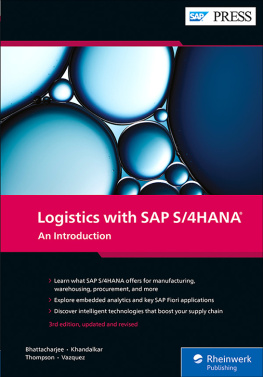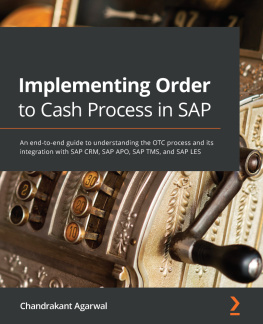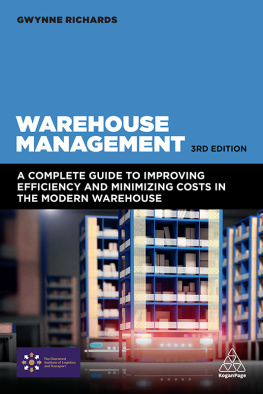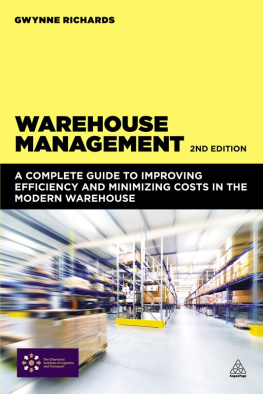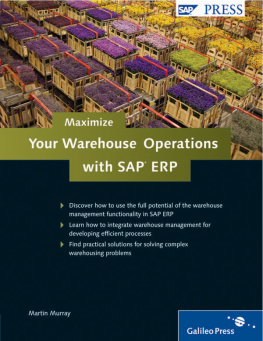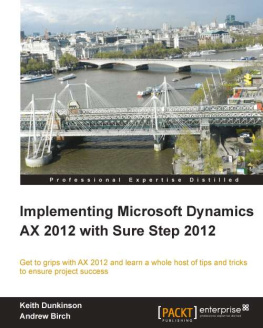Warehouse Management
using
Microsoft Dynamics AX
AX 2012 R3
By Scott Hamilton, Ph.D.
Other Books by Scott Hamilton
Discrete Manufacturing Using Microsoft Dynamics AX 2012,
Visions Inc. (2012)
Food Products Manufacturing Using Microsoft Dynamics AX 2012,
Visions Inc. (2012)
Managing Process Manufacturing Using Microsoft Dynamics AX 2009,
Visions Inc. (2010)
Managing Wholesale Distribution Using Microsoft Dynamics AX 2009,
privately published (2010)
Managing Lean Manufacturing Using Microsoft Dynamics AX 2009,
Visions Inc. (2010)
Managing Your Supply Chain Using Microsoft Dynamics AX 2009,
Printing Arts (2009)
Managing Your Supply Chain Using Microsoft Dynamics AX 4.0,
Printing Arts (2007)
Managing Your Supply Chain Using Microsoft Axapta 3.0,
McGraw-Hill (2004)
Managing Your Supply Chain Using Microsoft Navision,
McGraw-Hill (2004)
Maximizing Your ERP System, McGraw-Hill (2003)
Managing Information: How Information Systems Impact Organizational
Strategy (with Gordon B. Davis), Business One Irwin (1993)
Copyright 2015 by Scott Hamilton. All rights reserved. Printed in the United States of America. Except as permitted under the United States Copyright Act of 1976, no part of this publication may be reproduced, stored in a retrieval system, or transmitted, in any form or by any means, electronic, mechanical, photocopying, recording, or otherwise, without the prior written permission of Scott Hamilton.
ISBN 0-9784976-2-7
The front cover photo depicts a lightning storm over Death Valley in California, and was taken by the nationally-recognized photographer Doug Peck (www.douglaspeckphotography.com).
Table of Contents
1.1 Suggestions for the Targeted Reader
1.2 Organization of Book Chapters
1.3 Reasons for Reading the Book
1.4 Prior Research and Scope of Book Topics
1.5 Business Process Modeling (BPM) Diagrams as a Learning Tool
1.6 Terminology Used in the Book
1.7 Baseline Model of Operations
1.8 Baseline Model of Operations for Process Manufacturing/Distribution
1.9 Summary of Case Studies
2.1 Major Options for Warehouse Management
2.2 Significance of the Inventory Status
2.3 Guidelines for Choosing the Basic vs Advanced Approach
2.4 Strategic Options and Illustrative Case Studies
2.5 Evolving Strategies for Strategic Options
2.6 Details of Case Studies
2.7 Comparing Approaches
2.8 Executive Summary
3.1 Summary of Warehouse-Related Transactions
3.2 Basic Inventory Transactions
3.3 Define a Non-WMS Warehouse and its Locations
3.4 Define Item-Related Policies for Warehouse Management
3.5 Calculate Space Utilization for a Non-WMS Warehouse
3.6 Executive Summary
4.1 Two Different Meanings of the Term Inventory Status
4.2 Significance of Inventory Status
4.3 Assign a Value for Inventory Status to Orders
4.4 Key Characteristics of Inventory Status
4.5 Assign Inventory Status during the Receiving Process
4.6 Change Inventory Status for Existing Inventory
4.7 Allowable Transactions for Inventory with a Blocked Inventory Status
4.8 Assign Inventory Status During the Purchase Order Arrival process
4.9 Additional Case Studies
4.10 Executive Summary
5.1 Basic Process for Purchase Order Receiving
5.2 Additional Steps in the Basic Process
5.3 Life Cycles Related to the Basic Process
5.4 Reversing Transactions in the Basic Process
5.5 Key Constructs for Purchase Order Receiving
5.6 Major Variations for Purchase Order Receiving
5.7 Minor Variations
5.8 Receiving Inspection for Purchase Order Arrivals
5.9 Returns to Vendor
5.10 Additional Case Studies
5.11 Executive Summary
6.1 Basic Process for Sales Order Picking/Shipping
6.2 Additional Steps in the Basic Process
6.3 Life Cycles Related to the Basic Process
6.4 Reversing Transactions in the Basic Process
6.5 Key Constructs for Sales Order Picking/Shipping
6.6 Major Variations of Sales Order Picking/Shipping
6.7 Minor Variations
6.8 Selection Criteria for Generating Sales Order Picking Lists
6.9 Generate Picking Lists Using the Picking Workbench form
6.10 Extended Explanation of Related Life Cycles for Picking/Shipping
6.11 Additional Case Studies
6.12 Executive Summary
7.1 Basic Process for Transfer Order Picking/Shipping
7.2 Additional Steps in the Basic Process
7.3 Life Cycles Related to the Basic Process
7.4 Reversing Transactions in the Basic Process
7.5 Key Constructs for Transfer Order Picking/Shipping
7.6 Major Variations for Transfer Order Picking/Shipping
7.7 Minor Variations of Transfer Order Picking/Shipping
7.8 Executive Summary
8.1 Basic Process for Transfer Order Receiving
8.2 Additional Steps in the Basic Process
8.3 Life Cycles related to the Basic Process
8.4 Reversing Transactions in the Basic Process
8.5 Key Constructs in the Basic Process
8.6 Variations of Transfer Order Receiving
8.7 Additional Case Studies
8.8 Executive Summary
9.1 Production Scenario #1 for Internal Manufacturing
9.2 Basic Process for Production Order Picking
9.3 Additional Steps in the Basic Process
9.4 Life Cycles Related to the Basic Process
9.5 Reversing Transactions in the Basic Process
9.6 Key Constructs in the Basic Process
9.7 Major Variations of Production Order Picking
9.8 Significance of the Picking List Journal for Production Orders
9.9 Define the Warehouse Source of Components in BOM/Routing Information
9.10 Additional Case Studies
9.11 Executive Summary
10.1 Basic Process for Production Order Receiving
10.2 Additional Steps in the Basic Process
10.3 Life Cycles related to the Basic Process
10.4 Reversing Transactions in the Basic Process
10.5 Major Variations of Production Order Receiving
10.6 Alternatives for Reporting the Finished Quantity
10.7 Production Inspection of Finished Quantities
10.8 Report Production using a BOM Journal
10.9 Executive Summary
11.1 Variations of Supplied Material for Subcontracted Production
11.2 Variations of Receiving a Finished Quantity for Subcontracted Production
11.3 Key Constructs for Subcontracted Production
11.4 Case Studies for Subcontracted Production
11.5 Executive Summary
12.1 Transportation Basics for Sales Orders
12.2 Transportation Basics for Transfer Orders
12.3 Transportation Basics for Purchase Orders
12.4 Carrier Interface Information for Sales Order Shipments
12.5 Executive Summary
13.1 Summary of Warehouse-Related Transactions
13.2 Significance of License Plates
13.3 Basic Inventory Transactions
13.4 Significance of Inventory Status (and the Combined Disposition Code)
13.5 Define a WMS-Enabled Warehouse and its Locations
13.6 Define Item-Related Policies for Warehouse Management
13.7 Executive Summary
14.1 Types of Work Orders
14.2 Structure of a Work Order (aka Work ID)
14.3 Creating a Work Order
14.4 Define the Mobile Device Menu Items related to Work Orders
14.5 Define the Mobile Device Menu Items for Indirect Activities
14.6 Impact of Work Orders on Inventory Transaction History
14.7 Executive Summary
15.1 Basic Process for Purchase Order Receiving
15.2 Additional Steps in the Basic Process
15.3 Life Cycles related to the Basic Process
15.5 Key Constructs in the Basic Process for Purchase Order Receiving
15.6 Major Variations for Purchase Order Receiving
Next page

